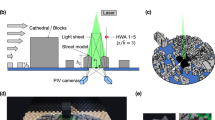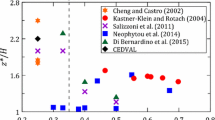Abstract
Wind tunnel measurements of the boundary layer flow over a very rough surface comprising a staggered array of cubes are presented and discussed. Attention is concentrated on the near-wall region, including the canopy region below the tops of the roughness elements. Particle image velocimetry (PIV) and laser Doppler anemometry were used to identify the dominant features of the mean and turbulent flow and these are compared with the better-known features of the flow above the roughness. Spatial correlation data, extracted from the PIV images, are used to provide information about eddy structures and it is shown that these differ in some crucial respects from those typical of more classical boundary layers. The implications of the results are discussed in terms of their relevance to flows within the urban environment.



















Similar content being viewed by others
References
Adrian R, Meinhart C, Tomkins C (2000) Vortex organisation in the outer region of the turbulent boundary layer. J Fluid Mech 422:1–54
Bohm M, Finnigan JJ, Raupach MR (2000) Dispersive fluxes in canopy flows: just how important are they? In: Proceedings of 24th conference on agricultural and forest meteorology, University of California, Davis, CA, 14–18th August. American Meteorology Society, Boston, pp 106–107
Bottema M (1997) Urban roughness modelling in relation to pollution dispersion. Atmos Environ 31:3059–3075
Castro IP (2007) Rough wall boundary layers: mean flow universality. J Fluid Mech 585:469–485
Castro IP, Robins AG (1977) The flow around a surface-mounted cube in laminar and turbulent streams. J Fluid Mech 79:307–335
Castro IP, Cheng H, Reynolds R (2006) Turbulence over urban-type roughness: deductions from wind-tunnel measurements. Bound Layer Meteorol 118:109–131
Cheng H, Castro IP (2002) Near-wall flow over urban-like roughness. Bound Layer Meteorol 105:411–432
Cionco RM (1972) A wind profile index for canopy flow. Bound Layer Meteorol 3:255–263
Coceal O, Belcher SE (2004) A canopy model of mean winds through urban areas. QJR Meteorol Soc 130:1349–1372
Coceal O, Thomas TG, Castro IP, Belcher SE (2006) Mean flow and turbulence statistics over groups of urban-like cubical obstacles. Bound Layer Meteorol 121:491–519
Coceal O, Thomas TG, Belcher SE (2007) Spatial variability of flow statistics within regular building arrays. Bound Layer Meteorol 125:537–552
Davidson MJ, Snyder WH, Lawson RE, Hunt JCR (1996) Wind tunnel simulations of plume dispersion through groups of obstacles. Atmos Environ 22:3175–3731
DeGraaff D, Eaton J (2000) Reynolds-number scaling of the flat-plate turbulent boundary layer. J Fluid Mech 422:319–346
Erm L, Joubert P (1991) Low Reynolds number turbulent boundary layers. J Fluid Mech 230:1–44
Finnigan J (2000) Turbulence in plant canopies. Ann Rev Fluid Mech 32:519–572
Ganapathisubramani B, Hutchins N, Hambleton W, Longmire E, Marusic I (2005) Investigation of large-scale coherence in a turbulent boundary layer using two-point correlations. J Fluid Mech 524:57–80
Grachev Y, Hunt JCR (2006) (eds) Flow through plant canopies and urban terrains, NATO-ASI Summer School. Kluwer, Dordrecht
Grimmond CSB, Oke TR (1999) Aerodynamic properties of urban areas derived from analysis of surface form. J Appl Meteorol 38:1262–1292
Hunt JCR, Eames I, Westerweel J (2006) Mechanics of inhomogeneous turbulence and interfacial layers. J Fluid Mech 554:499–519
Jiménez J (2004) Turbulent flows over rough walls. Ann Rev Fluid Mech 36:173–196
Kastner-Klein P, Rotach M (2004) Mean flow and turbulence characteristics in an urban roughness sublayer. Bound Layer Meteorol 111:55–84
Kastner-Klein P, Berkowicz R, Britter RE (2004) The influence of street architecture on flow and dispersion in street canyons. Meteorol Atmos Phys 87:121–131
Katul GG, Chang WH (1999) Principal length scales in second-order closure models for canopy turbulence. J Appl Meteorol 38:1631–1643
Krogstad PA, Antonia RA (1999) Surface roughness effects in turbulent boundary layers. Exp Fluids 27:450–460
Krogstad PA, Antonia RA, Browne L (1992) Comparison between rough- and smooth-wall turbulent boundary layers. J Fluid Mech 245:599–617
Krogstad PA, Andersson HI, Bakken OM, Ashrafian A (2005) An experimental and numerical study of channel flow with rough walls. J Fluid Mech 530:327–352
Lee S-H, Sung HJ (2007) Direct numerical simulation of the turbulent boundary layer with a rod-roughened wall. J Fluid Mech 584:125–146
Lu S, Willmarth W (1973) Measurements of the structure of the Reynolds stress in a turbulent boundary layer. J Fluid Mech 60:481–511
MacDonald R (2000) Modelling the mean velocity profile in the urban canopy layer. Bound Layer Meteorol 97:25–45
Martinuzzi RJ, Tropea C (1993) The flow around surface-mounted prismatic obstacles placed in a fully developed channel flow. ASME J Fluids Eng 115:85–92
Marusic I (2001) On the role of large-scale structures in wall turbulence. Phys Fluids 13:735–743
Poggi D, Katul GG, Albertosn JD (2004a) A note on the contribution of dispersive fluxes to momentum transfer within canopies. Bound Layer Meteorol 111:615–621
Poggi D, Porporato A, Ridolfi L, Albertosn JD, Katul GG (2004b) The effect of vegetation density on canopy sub-layer turbulence. Bound Layer Meteorol 111:565–587
Raupach M (1981) Conditional statistics of Reynolds stress in rough-wall and smooth-wall turbulent boundary layers. J Fluid Mech 108:363–382
Raupach M, Antonia RA, Rajagopalan S (1991) Rough-wall turbulent boundary layers. Appl Mech Rev 44:1–25
Reynolds RT, Hayden P, Robins AG, Castro IP (2007) Spanwise variations in nominally two-dimensional rough-wall boundary layers. Exp Fluids 42:311–320
Rotach MWL, Vogt R, Bernhofer C, Batchvarova E et al (2007) BUBBLE—an urban boundary layer meteorology project. Theor Appl Climat 81:231–236
Tutu N, Chevray R (1975) Cross wire anemometry in high intensity turbulence. J Fluid Mech 71:785–800
Xie ZT, Coceal O, Castro IP (2008) Large-Eddy simulation of flows over random urban-like obstacles. Bound Layer Meteorol (in press)
Acknowledgments
This work could not have been undertaken without the willing help of technical staff in the School of Engineering Sciences; in particular we are indebted to Mr. M. Tudor-Pole and the late Dr. C. Williams. RR thanks the School for a Research Scholarship. The work was supported by the UWERN programme of the Natural Environment Research Council (under NCAS grant number DST/26/39), for which we are very grateful. We also wish to thank the anonymous referees for a number of helpful comments.
Author information
Authors and Affiliations
Corresponding author
Rights and permissions
About this article
Cite this article
Reynolds, R.T., Castro, I.P. Measurements in an urban-type boundary layer. Exp Fluids 45, 141–156 (2008). https://doi.org/10.1007/s00348-008-0470-z
Received:
Revised:
Accepted:
Published:
Issue Date:
DOI: https://doi.org/10.1007/s00348-008-0470-z




